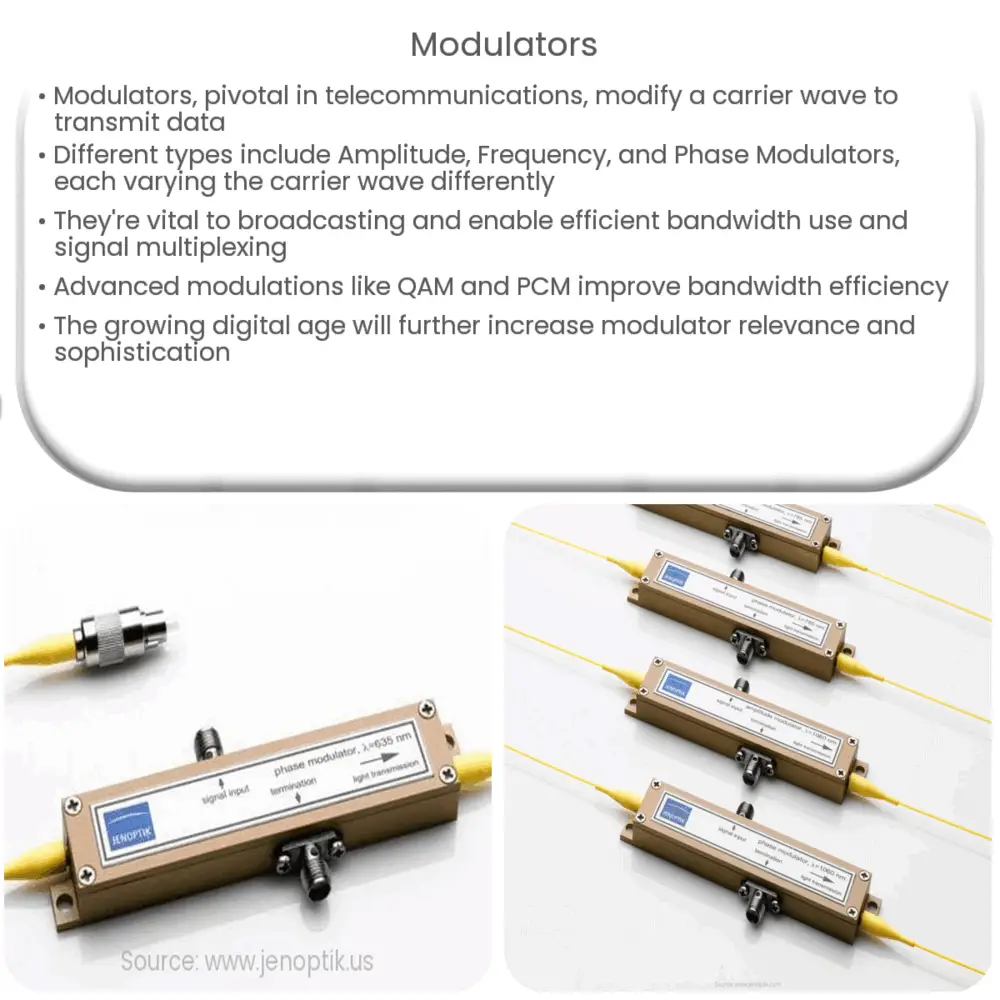Dive into the world of modulators: understand their types, role in telecommunications, advanced modulation techniques, and future scope.

Understanding Modulators
In the broad world of electronics and telecommunications, the term ‘modulator’ has a significant importance. A modulator is a device that performs modulation, a process where the characteristics of a carrier wave are varied according to the information signal. This is the essence of how data is transmitted over various distances, enabling devices to communicate.
Types of Modulators
- Amplitude Modulator: As the name suggests, an amplitude modulator varies the amplitude of the carrier wave according to the input signal’s intensity. This type of modulation is called Amplitude Modulation (AM).
- Frequency Modulator: Here, the frequency of the carrier wave is altered depending on the instantaneous value of the modulating signal. This is known as Frequency Modulation (FM).
- Phase Modulator: In this type, the phase of the carrier signal changes in accordance with the input message signal, which is termed as Phase Modulation (PM).
Applications of Modulators
Modulators find their applications in a myriad of places. Starting from the most mundane to the most advanced technologies, modulators play a crucial role. They are fundamental to radio and television broadcasting, where they enable signals to be transmitted over long distances.
Working Principle of Modulators
At the heart of a modulator, the basic principle is to superimpose the message signal onto the carrier signal. This process changes one or more properties of the carrier signal, such as its amplitude, frequency, or phase, depending on the type of modulator in use.
Importance of Modulation
Modulation is a critical concept in telecommunications. It enables efficient use of bandwidth, reducing the chance of signal overlap and interference. It also allows multiple signals to be transmitted simultaneously over a single channel, a concept known as multiplexing. Modulation can also improve the quality of signal reception and allows signals to be broadcasted over greater distances without significant loss of information.
Up next, we’ll delve into the advanced types of modulation and the future scope of modulators in the world of digital communication.
Advanced Types of Modulation
With the advent of digital technology, modulation techniques have also evolved. The more advanced forms of modulation include:
- Quadrature Amplitude Modulation (QAM): This technique combines both Amplitude Modulation (AM) and Phase Modulation (PM) to transmit two different signals simultaneously on the same channel, thereby increasing the bandwidth efficiency.
- Pulse Code Modulation (PCM): PCM is a method used to digitally represent analog signals. In PCM, the amplitude of the analog signal is sampled regularly at uniform intervals, and each sample is quantized to the nearest value within a range of digital steps.
- Pulse Amplitude Modulation (PAM): PAM is a modulation technique where the amplitude of the pulse is varied according to the instantaneous amplitude of the message signal.
Future of Modulators
As we continue to march forward into the digital age, the importance and role of modulators in telecommunications and data transmission will only increase. Emerging technologies such as quantum computing and advanced wireless communication systems like 5G and beyond will require more sophisticated modulation techniques. The quest for higher bandwidth efficiency, lower energy consumption, and better signal quality will drive the continual evolution of modulator design and implementation.
Conclusion
In conclusion, modulators, serving as the backbone of our telecommunications systems, play an essential role in the way we communicate and share information. They allow us to transmit data over significant distances, improve signal quality, and enable the simultaneous transmission of multiple signals. As we embrace more advanced digital technologies, the relevance and sophistication of modulators are set to expand, offering exciting opportunities for innovation and development in the field of telecommunications and beyond. Understanding the function and importance of modulators is, therefore, a fundamental requirement for anyone interested in telecommunications, electronics, or digital technologies.

